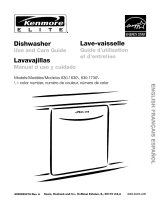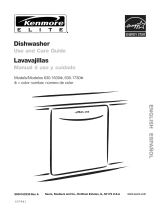
21
Statement of Limited Product Warranty
Bosch Dishwashers
What this Warranty Covers & Who it Applies to: The limited warranty
provided BSH Home Appliances (“Bosch”) in this Statement of Limited
Product Warranty applies only to Bosch dishwashers (“Product”) sold to
you, the rst using purchaser, provided that the Product was purchased:
(1) for your normal, household (non-commercial) use, and has in fact at
all times only been used for normal household purposes; (2) new at retail
(not a display, “as is”, or previously returned model), and not for resale, or
commercial use; and (3) within the United States or Canada, and has at
all times remained within the country of original purchase. The warranties
stated herein apply only to the rst purchaser of the Product and are not
transferable.
• Please make sure to return your registration card; while not
necessary to effectuate warranty coverage, it is the best way for
Bosch to notify you in the unlikely event of a safety notice or product
recall.
How Long the Warranty Lasts: Bosch warrants that the Product is free
from defects in materials and workmanship for a period of three hundred
sixty ve (365) days (i.e., 1 year) from the date of purchase. The foregoing
timeline begins to run upon the date of purchase, and shall not be stalled,
tolled, extended, or suspended, for any reason whatsoever. Labor and
shipping costs are included in this basic coverage.
Extended Limited Warranty: Bosch also provides these additional limited
warranties:
• 2 Year Limited Warranty: Bosch will repair or replace any
component that proves to be defective in materials or workmanship
(excludes labor charges).
• 5 Year Limited Warranty on Electronics: Bosch will repair or
replace any Bosch microprocessor or printed circuit board if it
proves to be defective in materials or workmanship (excludes labor
charges).
• 5 Year Limited Warranty on Dish Racks: Bosch will replace the
upper or lower dish rack (excluding rack components), if the rack
proves defective in materials or workmanship (excludes labor
charges).
• Lifetime Warranty against Stainless Steel Rust Through: Bosch
will replace your dishwasher with the same model or a current
model that is substantially equivalent or better in functionality, if
the inner liner should rust through (excludes labor charges). Bosch
will replace the stainless steel door if the door should rust through
(excludes labor charges).
The foregoing timeline begins to run upon the date of purchase, and
shall not be stalled, tolled, extended, or suspended, for any reason
whatsoever.
Repair/Replace as Your Exclusive Remedy: During this warranty period,
Bosch or one of its authorized service providers will repair your Product
without charge to you (subject to certain limitations stated herein) if your
Product proves to have been manufactured with a defect in materials or
workmanship. If reasonable attempts to repair the Product have been
made without success, then Bosch will replace your Product (upgraded
models may be available to you, in Bosch’s sole discretion, for an additional
charge). All removed parts and components shall become the property
of Bosch at its sole option. All replaced and/or repaired parts shall assume
the identity of the original part for purposes of this warranty and this
warranty shall not be extended with respect to such parts. Bosch’s sole
liability and responsibility hereunder is to repair manufacturer-defective
Product only, using a Bosch-authorized service provider during normal
business hours. For safety and property damage concerns, Bosch highly
recommends that you do not attempt to repair the Product yourself, or
use an un-authorized servicer; Bosch will have no responsibility or liability
for repairs or work performed by a non-authorized servicer. If you choose
to have someone other than an authorized service provider work on your
Product, THIS WARRANTY WILL AUTOMATICALLY BECOME NULL AND VOID.
Authorized service providers are those persons or companies that have been
specially trained on Bosch products, and who possess, in Bosch’s opinion,
a superior reputation for customer service and technical ability (note that
they are independent entities and are not agents, partners, afliates or
representatives of Bosch). Notwithstanding the foregoing, Bosch will not
incur any liability, or have responsibility, for the Product if it is located in a
remote area (more than 100 miles from an authorized service
provider) or is reasonably inaccessible, hazardous, threatening, or
treacherous locale, surroundings, or environment; in any such event, if
you request, Bosch would still pay for labor and parts and ship the parts to
the nearest authorized service provider, but you would still be fully liable
and responsible for any travel time or other special charges by the service
company, assuming they agree to make the service call.
Out of Warranty Product: Bosch is under no obligation, at law or
otherwise, to provide you with any concessions, including repairs,
pro-rates, or Product replacement, once this warranty has expired.
Warranty Exclusions: The warranty coverage described herein excludes
all defects or damage that are not the direct fault of Bosch, including
without limitation, one or more of the following: (1) use of the Product in
anything other than its normal, customary and intended manner (including
without limitation, any form of commercial use, use or storage of an indoor
product outdoors, use of the Product in conjunction with air or water-going
vessels); (2) any party’s willful misconduct, negligence, misuse, abuse,
accidents, neglect, improper operation, failure to maintain, improper or
negligent installation, tampering, failure to follow operating instructions,
mishandling, unauthorized service (including self-performed “xing” or
exploration of the appliance’s internal workings); (3) adjustment, alteration
or modication of any kind; (4) a failure to comply with any applicable state,
local, city, or county electrical, plumbing and/or building codes, regulations,
or laws, including failure to install the product in strict conformity with
local re and building codes and regulations; (5) ordinary wear and
tear, spills of food, liquid, grease accumulations, or other substances
that accumulate on, in, or around the Product; and (6) any external,
elemental and/or environmental forces and factors, including without
limitation, rain, wind, sand, oods, res, mud slides, freezing temperatures,
excessive moisture or extended exposure to humidity, lightning, power
surges, structural failures surrounding the appliance, and acts of God. In
no event shall Bosch have any liability or responsibility whatsoever for
damage to surrounding property, including cabinetry, oors, ceilings,
and other structures or objects around the Product. Also excluded from
this warranty are scratches, nicks, minor dents, and cosmetic damages on
external surfaces and exposed parts; Products on which the serial numbers
have been altered, defaced, or removed; service visits to teach you how to
use the Product, or visits where there is nothing wrong with the Product;
correction of installation problems (you are solely responsible for any
structure and setting for the Product, including all electrical, plumbing
or other connecting facilities, for proper foundation/ooring, and for any
alterations including without limitation cabinetry, walls, oors, shelving,
etc.); and resetting of breakers or fuses.
THE PERIOD THAT THIS EXPRESS LIMITED WARRANTY IS EFFECTIVE. IN
REMODELLING EXPENSES IN EXCESS OF DIRECT DAMAGES WHICH
SOME STATES DO NOT ALLOW THE EXCLUSION OR LIMITATION OF
NOT ALLOW LIMITATIONS ON HOW LONG AN IMPLIED WARRANTY
HAVE OTHER RIGHTS WHICH VARY FROM STATE TO STATE. No attempt
to alter, modify or amend this warranty shall be effective unless authorized
in writing by an ofcer of BSH.
How to Obtain Warranty Service: TO OBTAIN WARRANTY SERVICE FOR
YOUR PRODUCT, YOU SHOULD CONTACT THE NEAREST BOSCH AUTHORIZED
SERVICE CENTER, OR CALL 800-944-2904, or write Bosch at: BSH Home
Appliances - 5551 McFadden Avenue, Huntington Beach, CA 92649 /






















